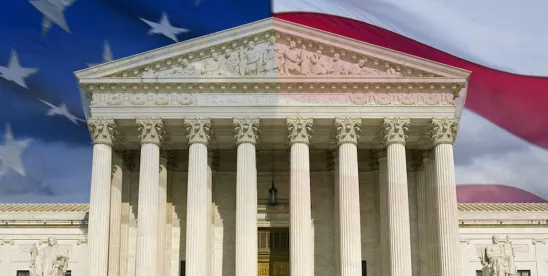“How clear is clear?” asked Justice Antonin Scalia, famously. On Friday, the Supreme Court made absolutely clear that Chevron is dead. Judicial deference to agency interpretations of statutory ambiguities is no longer the law of the land. The case is Loper Bright Enterprises v. Raimondo. The Supreme Court’s slip opinion is available here.
Writing for a 6-3 majority, the Chief Justice explained the almost accidental birth of Chevron deference, its remarkable expansion as modern doctrine, and its progressive deflation in more recent years. The Court held that, throughout its rise and fall in popularity, the deference doctrine was fatally inconsistent with both the mandate of Article 3 of the US Constitution and the Congressional prescription in the Administrative Procedure Act: it is for judges to say what the law is, without bending to the contrary wishes of any other authority.
Under Chevron, when reviewing an agency’s action, federal courts had been instructed to assess, first, whether Congress had spoken to the precise question at issue and, if not, to defer to the agency’s interpretation so long as it offered a permissible construction of the statute — even if the reviewing court would read the statute differently. Such deference eclipsed the court’s authority to find and apply the best interpretation of the statute. The additional latitude that Chevron afforded agencies led at times to swings between widely different agency interpretations as Presidential administrations changed and pursued different policy preferences based on the same statutory language. Under Chevron, and guided by later precedent like Brand X, courts accepted these interpretative swings so long as they fell within the statute’s permissible range of construction, regardless of the court’s own view of the statute.
In its opinion, the Court is quick to note that courts must continue to respect the discretionary authority of agencies where the courts find that Congress in fact conferred such discretion — such as by using statutory terms like “reasonable” or “appropriate.” Slip op. at 26, 17. In such instances, the reviewing court’s role is to “independently identify and respect such delegations of authority, police the outer statutory boundaries of those delegations, and ensure that agencies exercise their discretion consistent with the APA.” Slip op. at 26.
While the Court today abandons Chevron’s directive of deference — removing “a decaying husk with bold pretensions” — it does not sweep the legs from under the many court decisions that have applied Chevron deference in the past. The Court reminds us that mistaken reliance on Chevron does not conclusively determine that these past decisions were themselves wrong, and stare decisis may also justify preserving them.
Loper Bright continues a trend in Supreme Court jurisprudence that tends to limit the authority of the Executive Branch, favoring Congress or the Court in the Constitutional balance of power.
Implications for Courts
Removing Chevron deference frees federal courts to review agency actions under the standards of the Administrative Procedure Act. APA Section 706 directs that “all relevant questions of law” are to be decided by the courts in the first instance (de novo), and it provides no different standard when evaluating questions of law that arise from ambiguous or incomplete statutes, where Chevron previously reigned. In each case, the task of the court will be to assess “whether the law means what the agency says.” Slip op. at 15 citing Perez v. MBA, 575 U.S. 92, 109 (2015). To be sure, a court must consider the agency’s justification for its legal interpretation, giving “due respect” to the “views of the Executive Branch” as the courts “do their ordinary job of interpreting statutes” (slip op. at 25) and according such weight as the justification itself bears based on its thoroughness, reasoning, consistency, and “all those factors which give it power to persuade, if lacking power to control” (slip op. at 10 citing Skidmore v. Swift & Co., 323 U.S. 134, 140 (1944). In the end, however, the court alone has the responsibility to decide whether the statute authorized the agency action under review, and in so doing the court will apply the court’s view of the statute’s “single, best meaning.” Slip op. at 22.
The majority opinion mentions and leaves untouched other important Supreme Court decisions governing the role of the court when reviewing agency action. As noted, it breathes life into Skidmore. As important, it cites approvingly to West Virginia v. EPA, 597 U.S. 697 (2022), which adopted the Major Questions Doctrine under which courts are to be skeptical of finding large delegations of Congressional authority in mouseholes of statutory text. Slip op. at 28.
So, what rubric should a court apply when reviewing agency action? The opinion offers no succinct and comprehensive prescription. Still, the reasoning of the opinion and the touchpoints offered in the Court’s cited cases permit a rough outline — see the Appendix below. Regardless, we are certain to have an exploratory period in which courts test their new footing. Whether future court decisions converge toward a stable and uniform rubric for statutory review remains to be seen. Even applying a consistent analytical rubric, guided by traditional rules of statutory construction, does not mean courts will necessarily come to the same “best” readings of a statute. A concern in losing agency deference is the replacement of a national viewpoint (via the federal agency) with inconsistent views as different courts come to their own conclusions about the same statutory text. Of course, divergent court decisions are not new in other contexts, and judicial waywardness is ultimately constrained by the authority of higher courts.
Implications for Agencies
Agencies face a new future. While they have always sought to justify their rulemaking efforts on the basis of statutory authority, Chevron afforded them a measure of grace — some would say a large measure of power — in devising a statutory interpretation that suited their policy goals. Loper Bright instructs federal courts to look carefully at the law themselves and not to defer to agency interpretations that are merely “permissible.” As the Court explained: “In the business of statutory construction, if it is not the best, it is not permissible.”
Agencies must now act with more discipline and with more attention to grounding their assertions of authority in the language and structure of the statutes themselves. For example, we have already seen a remarkable increase in the length of preambles to draft and final agency rules, often in order to set out a new presidential administration’s world view of the legal landscape. Recent examples include the SEC’s Climate Disclosure Rule, the BOEM’s Renewable Energy Leasing Modernization Rule, CEQ’s NEPA Phase 2 Rule, and the EPA’s Good Neighbor Rule (which the Court stayed earlier this week). These efforts are all going to be reviewed under the new direction from the Court.
Rulemakings from more distant times may not evade the implications of Loper Bright. The Court’s decision today in Corner Post v. Federal Reserve affirms that the general federal limitations period for challenging a rulemaking — six years unless otherwise specified — only begins to run after the plaintiff suffers injury, regardless of how much time has elapsed since the rulemaking. Thus, in Corner Post, a convenience store may even today challenge a rule issued in 2011 governing debit transaction fees, since the store was first injured by the rule in 2018 when it opened for business. The Court also rejected the view that facial challenges to a rule are held to a different standard than as-applied challenges, unless the statute so specifies. The majority’s opinion spars at length with the dissent on a close reading of the statute at issue in Corner Post, demonstrating that even Supreme Court justices will not always agree on the “best” reading of a statute.
The importance of the DC Circuit seems likely to grow, as it is the federal appellate court that most often assesses new agency rulemaking. Now its review will be unfettered by agency deference and focused on discerning and stating the meaning of a statutory provision. While its rulings do not necessarily have national scope, the court’s views are always instructive, and in important instances they are controlling. For example, the DC Circuit is an authorized venue for all appeals from final FERC and SEC administrative orders and is the only venue authorized for hearing challenges to EPA rules issued under the Clean Air Act or to a state’s failure to act on a water quality certification for pipelines authorized under the Natural Gas Act.
Implications for Permit Applicants and Other Regulated Entities
Project developers and others seeking permits from the federal government are not directly affected by today’s decision in Loper Bright, but the dialogue between permit applicant and agency may shift. Especially for complex projects, such as liquefied natural gas terminals, interstate pipelines, and offshore wind facilities, federal agencies have progressively extended their assertion of power to demand information and concessions from applicants based on ever-broader readings of the underlying statutes. These assertions of power, and their tenuous link to statutory text, are apt to come under more severe judicial scrutiny if and when applicants choose to challenge them. Loper Bright encourages — actually, requires — courts to come to their own conclusions about the underlying authority, rather than tolerate agency interpretations.
Apart from permitting, regulated entities facing federal enforcement actions or investigations may take note of both Loper Bright and the Supreme Court’s decision in SEC v. Jarkesy, which was issued the day before Loper Bright. It invalidated civil fines for charges of fraud imposed solely via agency tribunals without affording the constitutional right to a jury trial. Together, these cases raise the prospect of readier and more useful access to the courts to contest both enforcement methods and agency adjudications that have lost their tether to the statutory authority as discernible in the text. That being said, the Court in Loper Bright clearly distinguished an agency’s factual findings and legal determinations. Slip op. at 9. It reaffirmed that, under the Administrative Procedure Act, a court must accept an agency’s determination of fact if it is supported by substantial evidence in the record. Slip op. at 14. Over time, however, we expect to see regulated entities push against agencies more often where the boundaries of their statutory authority are suspect.
Conclusion
Judicial deference to agencies under Chevron has ended. Courts are directed to make their own independent assessment of whether the best reading of a statute supports the action taken by the agency and, if so, whether the agency took the action in accordance with the Administrative Procedure Act. Although the full implications of Loper Bright remain to be seen, it is clear that the Judicial Branch has strengthened its role in overseeing the burgeoning administrative state.
Appendix
Basic Rubric for Judicial Review of Agency Action, After Loper Bright
- What is the court’s best reading of the statute with respect to the issue presented by the agency’s action?
- The court applies the traditional tools of statutory construction to discern what the statute says on the issue. This “ordinary job” may be done with “due respect” for the merits of the agency’s view.
- If the issue is a Major Question, the court looks for clear statutory authority and, without it, will vacate agency action on the issue.
- If the statute confers discretion to the agency (e.g., by a broad grant of authority to the agency, or by using terms like “reasonable” or “appropriate”), the court determines what parameters Congress set for exercising the discretion. For example, the court may find that the statute limits the permissible range of action, identifies the purpose to be achieved by applying the authority, or specifies the method to be used in applying the authority.
- Is the agency’s action on this issue authorized by the statute, under the court’s best reading of the statute?
- The court will make this determination de novo, as it is a legal determination.
- If the statute does not authorize the action taken, the action is unlawful.
- If the statute both authorizes agency action and confers discretion to the agency, the court determines whether the agency’s action comports with the parameters Congress set for exercising discretion. If it does not, the agency action is unlawful.
- If the statute authorizes the agency’s action, does the agency’s action comport with the Administrative Procedure Act?
- For non-adjudicatory agency actions (such as permitting and rulemaking), the court will hold the action unlawful if it is arbitrary, capricious, an abuse of discretion, or otherwise not in accordance with law substantively or procedurally.
- For adjudicatory agency actions, the court will hold the action unlawful if (a) the agency’s factual findings are not supported by substantial evidence in the record (or unwarranted by the facts to the extent they are subject to trial de novo by the court); (b) its other conclusions, such as its interpretations and applications of law, are arbitrary, capricious, an abuse of discretion, or otherwise not in accordance with law; or (c) it failed to comply with required statutory or regulatory procedures.






 />i
/>i


